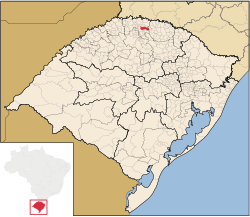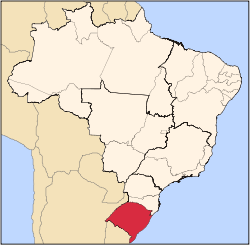Trindade do Sul | |
|---|---|
 Location in Rio Grande do Sul state | |
| Coordinates: 27°31′19″S52°53′38″W / 27.52194°S 52.89389°W | |
| Country | Brazil |
| Region | South |
| State | Rio Grande do Sul |
| Mesoregion | Noroeste Rio-Grandense |
| Microregion | Frederico Westphalen |
| Founded | December 15, 1987 |
| Government | |
| • Mayor | Luiz da Silva Rosa (PP) |
| Area | |
• Total | 268.417 km2 (103.636 sq mi) |
| Elevation | 640 m (2,100 ft) |
| Population (2020 [1] ) | |
• Total | 5,791 |
| • Density | 22/km2 (56/sq mi) |
| Demonym | Trindadense |
| Time zone | UTC−3 (BRT) |
| Website | www |
Trindade do Sul is a municipality in the state of Rio Grande do Sul, Brazil.



